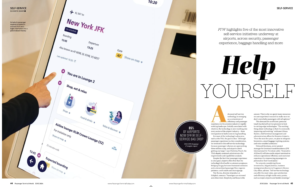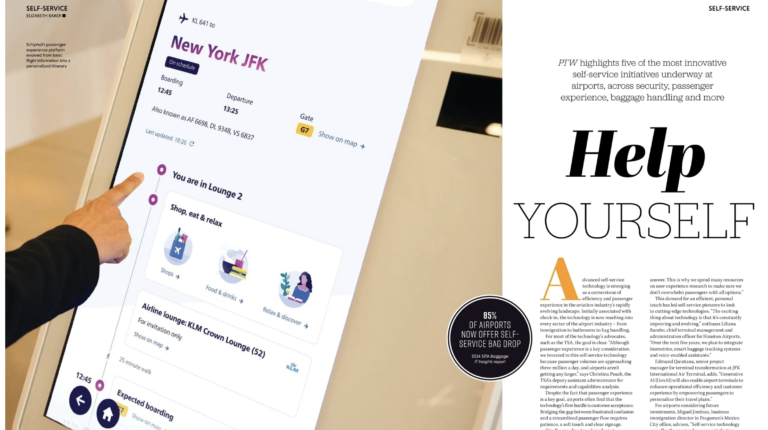PTW highlights five of the most innovative self-service initiatives underway at airports, across security, passenger experience, baggage handling and more.
Advanced self-service technology is emerging as a cornerstone of efficiency and passenger experience in the aviation industry’s rapidly evolving landscape. Initially associated with check-in, the technology is now reaching into every sector of the airport industry – from immigration to bathrooms to bag handling.
For most of the technology’s advocates, such as the TSA, the goal is clear. “Although passenger experience is a key consideration, we invested in this self-service technology because passenger volumes are approaching three million a day, and airports aren’t getting any larger,” says Christina Peach, the TSA’s deputy assistant administrator for requirements and capabilities analysis.
Despite the fact that passenger experience is a key goal, airports often find that the technology’s first hurdle is customer acceptance. Bridging the gap between frustrated confusion and a streamlined passenger flow requires patience, a soft touch and clear signage.
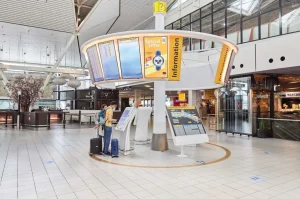
Tijn Borms, director of product at Schiphol, concurs: “Passengers are stressed and often tired. Simplicity and focus is the answer. This is why we spend many resources on user experience research to make sure we don’t overwhelm passengers with all options.”
This demand for an efficient, personal touch has led self-service pioneers to look to cutting-edge technologies. “The exciting thing about technology is that it’s constantly improving and evolving,” enthuses Liliana Rambo, chief terminal management and administration officer for Houston Airports, “Over the next five years, we plan to integrate biometrics, smart baggage tracking systems and voice-enabled assistants.”
Edmund Quintana, senior project manager for terminal transformation at JFK International Air Terminal, adds, “Generative AI (GenAI) will also enable airport terminals to enhance operational efficiency and customer experience by empowering passengers to personalize their travel plans.”
For airports considering future investments, Miguel Jiménez, business immigration director in Fragomen’s Mexico City office, advises, “Self-service technology can offer the most value, user satisfaction and efficiency at high-traffic entry points, such as major airports and border crossings.”
1 Information on the fly
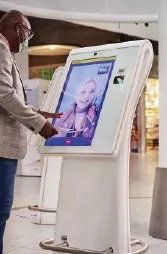
When Schiphol Airport’s Tijn Borms saw passengers taking pictures of the information on the airport’s self-service units (SSU), he was inspired to create the ‘move to mobile’ solution from scratch with his in-house team. The ‘move to mobile’ initiative enables passengers to seamlessly move whatever they are doing on the kiosk from the SSU to their mobile device.
Borms rationalizes, “The ultimate form of service and hospitality is a person coming to welcome and help you. This is, however, not very scalable. Back in 2017, Schiphol decided to replace the manned information desks with a digital kiosk solution. The desks had to be staffed around the clock and could not cope with the demand during peak hours. Additionally, these desks used a lot of retail space in the terminal.
“This is what the majority of the platform is about – handling as many queries as possible in a fully automated way so our agents can focus on the most complex queries where they can make more of a difference. We achieve this by offering a platform that can run on physical hardware in the terminal and any other device having a browser and an internet connection. The platform has features like flight information, an interactive map and Q&A.
“Manned information desks could not cope with the demand during peak hours”
Tijn Borms, Schiphol Airport
So far, the solution has managed to lower the cost (mostly staff) by 33%, handle three times more queries than before and cut the footprint of the information desks in the terminal by 50% – all improving the customer satisfaction score (CSAT).
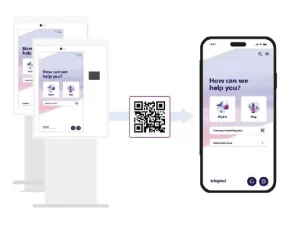
2 All-in-one security
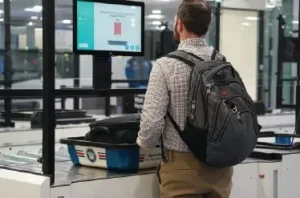
The Transportation Security Administration (TSA) and the Department of Homeland Security (DHS) Science and Technology Directorate (S&T) have unveiled a prototype checkpoint technology, the self-service screening system, at Harry Reid International Airport (LAS) in Las Vegas.
The TSA’s Christina Peach says, “It’s a whole system, meaning it’s inclusive of technology that’s intended to do screening of the person and the person’s carry-on luggage.” The 35 x 72ft (10.7 x 22m) prototype has a video monitor that provides step-by-step instructions for passengers to complete screening at their own pace. It also features automatic screening lanes (ASLs), an automated rerun line, a high-threat box and a Dormakaba gating system. Once passengers are cleared for travel, automated exit doors open.
“I thought, ‘It’s interesting, but this will never happen in my lifetime here at TSA’”
Michele Tomerlin, TSA
Michele Tomerlin, program manager of the TSA’s self-service screening system, reveals, “When I looked at the concept in 2018, I thought, ‘It’s very interesting, but this will never happen in my lifetime here at TSA.’ Yet here we are in 2024 and it’s already in an airport.”
3 Chain migration
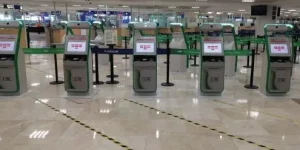
Holders of passports from Austria, Belgium, the Czech Republic, Finland, France, Germany, Hungary, Iceland, Italy, Japan, the Netherlands, Norway, Romania, South Korea, Spain, Sweden, Switzerland and the UK are now eligible to use self-service automated kiosks, supported by Fragomen, available at Mexico City and Cancun to expedite entry processes. Previously, this system was only available to passport holders from Mexico, Canada, Spain and the USA.
“Self-service automated kiosks have streamlined the immigration process”
Miguel Jiménez, Fragomen
To use the automated kiosks, visitors must hold a biometric passport with at least 180 days left until expiry at the time of entry and be 18+ years old.
Fragomen’s Miguel Jiménez reveals, “The self-service automated kiosks have streamlined the immigration process by enabling eligible visitors to swiftly navigate through passport scanning, biometric verification and questionnaire completion via touchscreens. This significantly reduces waiting times and paperwork burdens for visitors at international airports in Mexico City and Cancun, enhancing the overall traveler experience.”
However, Jiménez acknowledges there were important hurdles to clear to achieve these goals before the benefits of these technologies could be reaped. He notes, “Legal process viability and implementation are key considerations when implementing self-service projects, as compliance with regulations and standards is crucial for success. Additionally, factors such as cybersecurity, data privacy and infrastructure compatibility must be carefully evaluated to ensure the seamless integration and long-term sustainability of self-service technology.”
4 Bathroom monitoring

Airport operator Houston Airports has partnered with restroom management company Trax Analytics to use real-time data monitoring and smart vending machine technology to ensure that its free period products are always available to airport guests.
As a result of this partnership, George Bush Intercontinental Airport (IAH) now offers these products through the smart vending machine Aunt Flow. The Trax Analytics SmartRestroom technology, integrated with Aunt Flow dispensers, enables Houston Airports to monitor supply and refill the dispensers in real time – as it does for other bathroom necessities such as toilet paper and paper towels. IAH is the first airport to implement this technology.
Claire Coder, founder and CEO of Aunt Flow, comments, “According to a 2013 study by Free The Tampons, 86% of menstruating people have started their period unexpectedly in public without the supplies they needed. Airports providing menstrual products at no cost removes a significant stressor for travelers. It’s a low-cost, high-impact way to improve passenger comfort and satisfaction.”
“It’s impossible to envision the future of aviation without prioritizing self-service technology”
Diego Parra, Houston Airports
Houston Airports is also redeveloping two of the five terminals at IAH and expanding William P Hobby Airport. “All three projects are being designed to support self-service technology across the passenger journey,” says Diego Parra, director of the IT program management office for Houston Airports. “It’s impossible to envision the future of commercial aviation without prioritizing the role self-service technology will play for airlines, stakeholders and travelers.”
5 Pack your bags
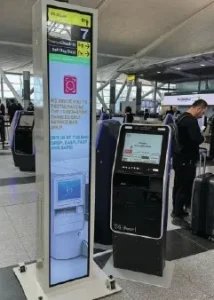
JFKIAT, the operator of Terminal 4 at JFK Airport in New York, has deployed Amadeus’s Auto Bag Drop and Next Generation Kiosk self-service technology to deliver a smooth and efficient passenger flow through Terminal 4. With this technology, passengers can check in and print their bag tag at one of 86 Amadeus kiosks before dropping their bag at one of the 42 Series 7 Auto Bag Drop units. All kiosks and bag drops will be equipped with a biometric function. Passengers will be able to enroll for facial recognition from home by capturing a selfie using their cell phone.
Edmund Quintana, senior project manager for terminal transformation at JFK, states, “Gone are the days of travelers queuing up to wait for check-in to open and then queue in line to see airline staff to check in. The airport terminals of tomorrow are quickly embracing new technologies. Self-service technologies use biometrics, visa checks are electronic and excess baggage payments are contactless, which will become the norm to transform the passenger experience.
Steve Tukavkin, vice president of IT and digital at JFKIAT, adds, “The deployment of this self-service technology enables an eased passenger process and flow at check-in. Investing in common-use self-service can lead to higher customer satisfaction and an increase in non-aeronautical revenue through retail and food and beverage sales. By streamlining processes not only at check-in but also at the security checkpoint, you can reduce wait times and enhance the passenger experience. By using data analytics, we can also identify pain points and optimize planning and terminal efficiency.”
“The airport terminals of tomorrow are quickly embracing new technologies”
Edmund Quintana, JFK
Quintana advises, “To implement this technology, it’s important to have early engagement with key stakeholders, primarily airlines, airport/terminal operations and support/maintenance service providers ahead of changes. For JFKIAT, the successful implementation of operational readiness activation and transition throughout the lifetime of the project resulted in the successful transition from a conventional method to a self-service automation process.”
This article originally appeared in the June 2024 issue of Passenger Terminal World. To view the magazine in full, click here.
